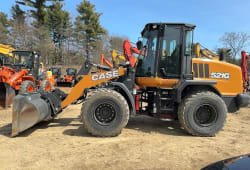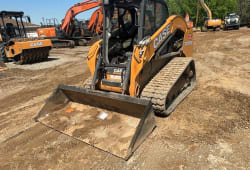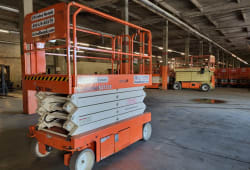Pneumatic Tires and its Purpose
8 Lectura mínima
)
mayo 6, 2024
What is a pneumatic tire?
Pneumatic tires, commonly known as regular air-filled tires, are used widely on vehicles like cars, motorcycles, and bicycles, as well as on heavy equipment in construction, agriculture, and industrial sectors. They provide cushioning and improved traction, which enhances handling and comfort. While they are effective and versatile, pneumatic tires are susceptible to flats due to punctures or valve failures. Despite this, they are favored for their ability to absorb shocks and offer better performance across various surfaces, making them a popular choice for most automotive and equipment applications.
Cushion or pneumatic tires: Which is better?
The choice between cushion and pneumatic tires depends largely on the specific requirements and operating conditions of the equipment or vehicle. Here’s a brief comparison to help determine which might be better for certain applications:
:format(webp)) Another type of tire is:
Another type of tire is:
Foam-filled:
tires are modified pneumatic tires injected with polyurethane foam, making them puncture-proof and low-maintenance. They offer similar cushioning to pneumatic tires without the risk of air loss. However, they are heavier, which may impact fuel efficiency and handling. These tires are ideal for areas with high puncture risks like construction sites or waste management facilities. However, for applications where weight and handling are critical, traditional pneumatic tires might be preferable due to their lighter weight and better performance characteristics
Advantages of Pneumatic Tires
:format(webp)) Pneumatic tires, known for their air-filled structure, offer a host of advantages that make them a preferred choice for a wide variety of vehicles and machinery. Here’s an in-depth exploration of their benefits:
Pneumatic tires, known for their air-filled structure, offer a host of advantages that make them a preferred choice for a wide variety of vehicles and machinery. Here’s an in-depth exploration of their benefits:
Shock Absorption:
One of the standout features of pneumatic tires is their exceptional shock absorption capabilities. The air inside the tires acts as a cushion, softening the impact from bumps and uneven surfaces. This results in a smoother ride, especially noticeable when traversing rough terrains such as construction sites, off-road paths, or uneven roads. This capability not only enhances comfort but also protects the vehicle from the jarring effects of rough surfaces..
Improved Traction:
The flexibility of pneumatic tires plays a crucial role in their ability to maintain effective traction on a variety of surfaces. Whether it's wet roads, muddy paths, or snowy conditions, the tread on pneumatic tires can adjust to the surface, providing a better grip. This adaptability helps in maintaining stability and safety, making these tires reliable in diverse driving conditions.
Comfort:
The air cushion within pneumatic tires significantly reduces the vibrations and bumps that are transmitted through the vehicle. This leads to a markedly more comfortable ride, which is particularly beneficial during long journeys or when traveling over rough terrain. Vehicle occupants experience less fatigue, which is essential for both personal comfort and commercial operations where driver fatigue can affect safety and productivity.
Reduced Wear on Equipment:
By effectively absorbing shocks, pneumatic tires also help in reducing the wear and tear on other vehicle components. The dampening effect of the air reduces the stress on the vehicle’s suspension system, brakes, and even the frame itself. This can lead to lower maintenance costs and longer intervals between repairs, extending the overall lifespan of the vehicle and its components.
Versatility:
Pneumatic tires are incredibly versatile, suitable for use on a wide range of terrains. This makes them ideal for a variety of applications, from personal vehicles that need to navigate city streets and highways, to specialized machinery that must operate in challenging environmental conditions such as farms, forests, or mining areas. Their ability to perform reliably in different settings adds to their appeal in both commercial and personal use.
Disadvantages of Pneumatic Tires
While pneumatic tires offer significant benefits in terms of comfort and performance, they also come with a set of disadvantages that might affect their suitability for certain applications. Understanding these drawbacks is crucial for anyone considering pneumatic tires for their vehicles. Here’s a detailed look at each of the main disadvantages:
Puncture Risk:
One of the primary vulnerabilities of pneumatic tires is their susceptibility to punctures and tears. The very feature that provides their comfort — air-filled cavities — also makes them prone to flats when they encounter sharp objects on the road or rough terrain. This can result in unexpected downtime, necessitating immediate repairs or even complete tire replacement, which can be both inconvenient and costly.
Maintenance Needs:
Pneumatic tires require regular maintenance to perform optimally. This includes frequent checks to ensure they are properly inflated, as well as inspections for signs of wear or damage. Neglecting these maintenance tasks can lead to premature tire wear, potential tire failure, and can compromise the safety and efficiency of the vehicle. Keeping them in good condition demands a consistent commitment to monitoring and care.
Temperature Sensitivity:
The air pressure inside pneumatic tires is affected by temperature fluctuations. In cold weather, the air inside the tire can contract, leading to under-inflation, while in hot conditions, it can expand and potentially cause over-inflation unless adjustments are made. This sensitivity requires operators to adjust tire pressure in response to temperature changes to maintain performance and safety, adding another layer of maintenance to their use.
Initial Cost:
Pneumatic tires generally have a higher initial cost compared to solid tires. This is due to their more complex construction and the higher quality materials required to manufacture them. The initial investment may be a significant consideration for businesses or individuals who need to equip multiple vehicles or maintain a large fleet.
Decreased Efficiency:
Under-inflated pneumatic tires can significantly decrease the efficiency of a vehicle. They have increased rolling resistance, which means the engine must work harder to move the vehicle forward, thus consuming more fuel. Additionally, under-inflation can adversely affect the handling and braking performance of the vehicle, potentially leading to unsafe driving conditions.
Do you need a Pneumatic Tire?
When determining if pneumatic tires are the right choice, these considerations will help determine whether pneumatic tires are the most appropriate choice based on the specific operational needs and conditions:
Terrain:
Pneumatic tires are particularly advantageous for navigating rough or uneven terrains. Their design allows for superior shock absorption, which helps in cushioning the impact that comes from operating on bumpy, rocky, or uneven surfaces. This feature is crucial for machinery used in construction sites, agricultural fields, or any outdoor area where the ground is not consistently smooth.
Comfort:
One of the primary benefits of pneumatic tires is the enhanced comfort they provide. By reducing the vibrations and bumps that are transmitted through the vehicle, these tires make for a significantly smoother ride. This is especially beneficial for vehicles that spend long hours in operation, as it can help reduce operator fatigue and improve overall job satisfaction.
Load Handling:
Pneumatic tires excel in evenly distributing the weight of both the vehicle and its cargo. This capability is essential when transporting heavy or sensitive loads, as it helps prevent damage to the cargo and maintains stability. The ability to handle significant weight makes pneumatic tires an excellent choice for commercial trucks, forklifts, and other heavy-duty vehicles.
Traction:
These tires offer superior traction across a variety of surfaces and conditions, including mud, snow, and slippery roads. The tread designs and the softer rubber material used in pneumatic tires allow for better grip and control, which is critical for safety in adverse or changing conditions.
Climate Effects:
Pneumatic tires are sensitive to temperature changes, which can affect air pressure inside the tire. It’s important to monitor these changes as fluctuations in temperature can lead to under-inflation or over-inflation, affecting performance and safety. This consideration is particularly important in environments with extreme temperatures or significant temperature variations.
Maintenance:
Owning pneumatic tires means committing to regular maintenance. This includes routine pressure checks to ensure they are inflated to the manufacturer’s recommended levels, as well as inspections for wear and tear. Proper maintenance is crucial to maximizing the lifespan and effectiveness of the tires, and to avoid unexpected failures that could compromise safety.
Puncture Risk:
Finally, consider the likelihood of punctures, which is a notable risk with pneumatic tires. In areas where the risk of encountering sharp objects is high, such as in environments with debris, construction materials, or rugged terrain, the potential for punctures might necessitate the consideration of alternative tire types, such as solid tires or foam-filled tires.

Caleb Woods is an experienced content specialist and an editor at Boom & Bucket, blending his journalism background with expertise in the heavy equipment industry. He delivers engaging, informative content to help professionals stay informed and make smarter decisions in the machinery market.











